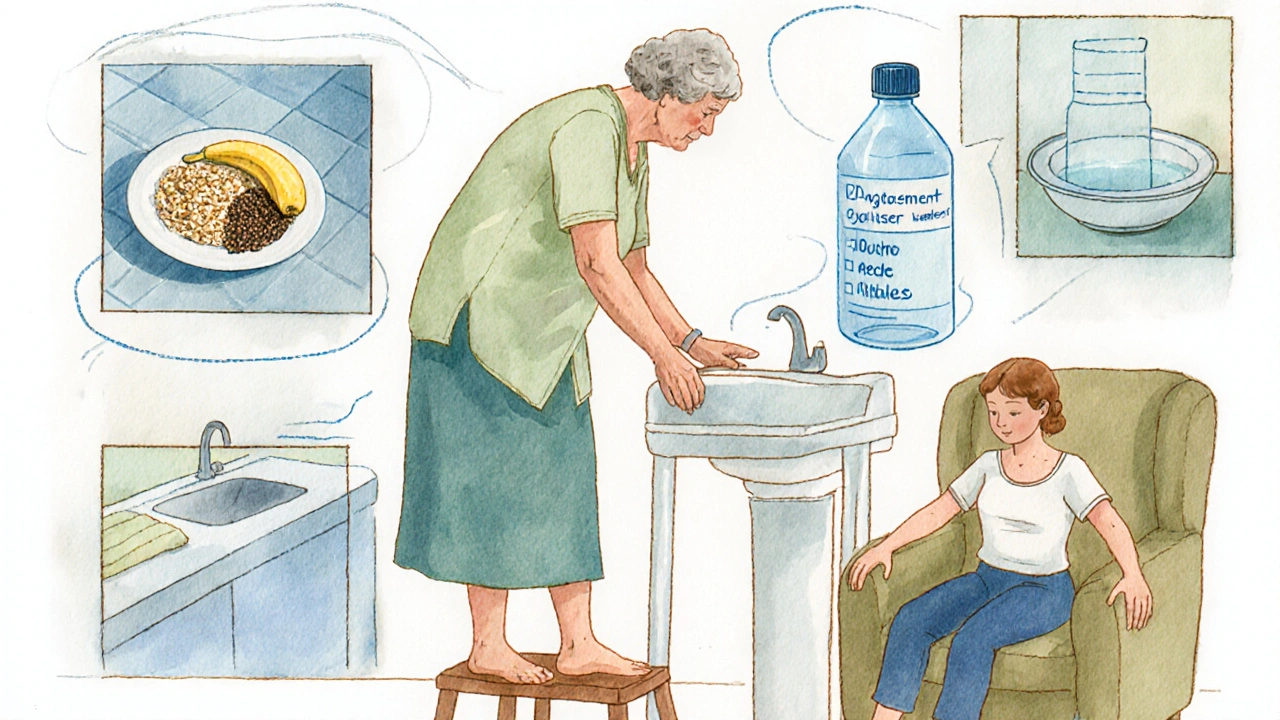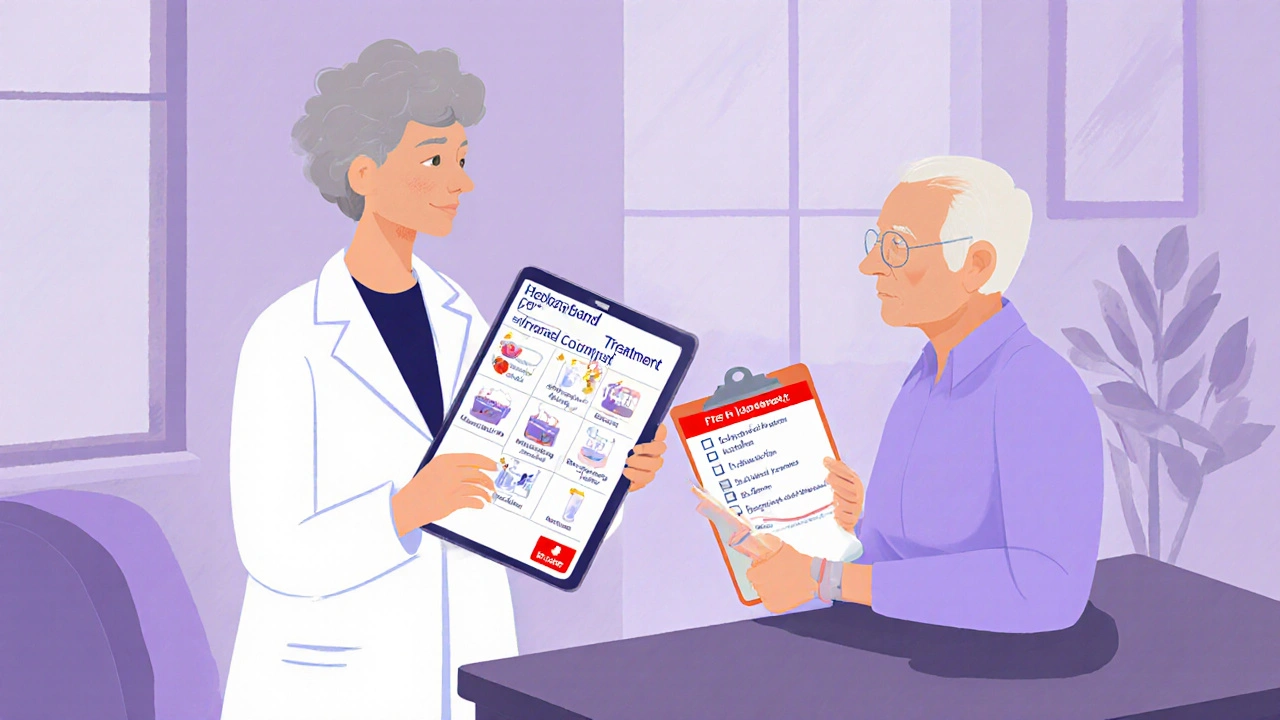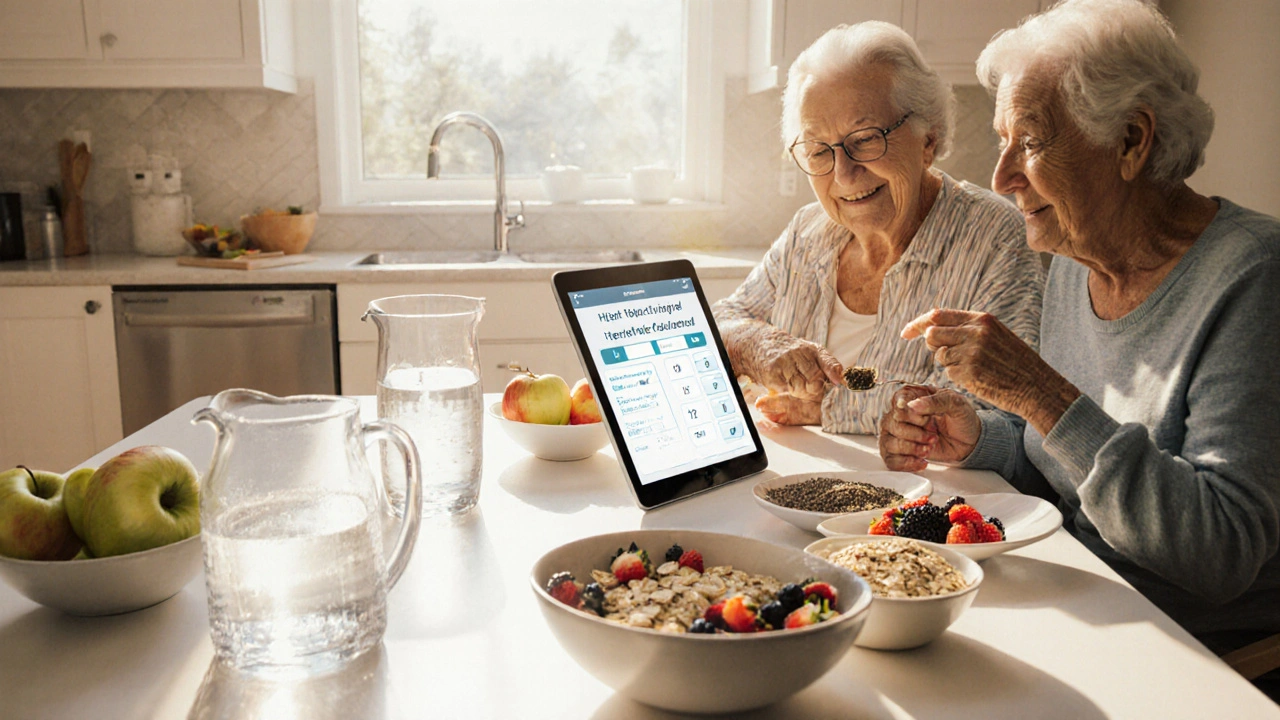Hemorrhoid Prevention & Management Calculator
Your Prevention Score:
Did you know that more than one in three people over 65 will experience a hemorrhoid flare‑up at some point? For seniors, the discomfort can be especially hard to ignore because age‑related changes make the condition trickier to manage. This guide cuts through the medical jargon and gives real‑world steps you can start today to keep hemorrhoids at bay and soothe them if they appear.
Key Takeaways
- Boosting dietary fiber to 25‑30g daily cuts constipation‑related strain by up to 40%.
- Gentle sitz baths for 10‑15minutes, three times a day, speed up healing.
- Low‑dose stool softeners are safe for most seniors and reduce the need for painful straining.
- Topical creams with hydrocortisone or witch‑hazel calm itching without systemic side effects.
- Seek professional care if bleeding persists more than a week or you notice a hard lump.
What Hemorrhoids are and why they matter for the Elderly
Hemorrhoids is a common condition where swollen veins in the rectal and anal area cause pain, itching, and occasional bleeding. In older adults, weakened tissue, slower bowel movements, and reduced mobility increase the likelihood of these veins becoming engorged. The result is not just discomfort-it can lead to anemia from chronic bleeding or infection if the skin breaks.
Age‑Specific Risk Factors
While anyone can develop hemorrhoids, seniors often face a cluster of aggravators:
- Chronic constipation - slower gut motility means harder stools and more straining.
- Low Dietary fiber intake, usually under 15g per day, leaves stool bulk insufficient to trigger gentle peristalsis.
- Reduced physical activity, which diminishes blood flow to the pelvic region.
- Medications such as opioids or certain antihypertensives that dry out the intestine.
- Prolonged sitting on hard surfaces, common during recovery from surgery or while watching TV.
Understanding these triggers is the first step toward an effective prevention plan.
Prevention Strategies That Actually Work
Below is a practical checklist you can print and hang on the fridge. Each item targets a specific cause identified above.
| Action | Why It Helps | How to Implement |
|---|---|---|
| Eat 25‑30g fiber | Softens stool, reduces straining | 1cup cooked oatmeal + 1medium apple + 2tbsp ground flaxseed |
| Drink 6‑8 cups water | Keeps stool hydrated | Carry a refillable bottle; sip every hour |
| Gentle Sitz bath after bowel movements | Relieves swelling, promotes blood flow | Warm water (not hot) for 10‑15min, 2‑3 times daily |
| Use Stool softener if needed | Prevents hard stools that tear tissue | Take docusate sodium 100mg once daily with breakfast |
| Move every 30‑45min | Improves pelvic circulation | Stand, stretch, or walk a few steps around the room |
Notice the emphasis on hemorrhoids prevention-the goal is to keep the veins from swelling in the first place.

Managing an Outbreak: First‑Line Home Care
If a hemorrhoid does flare, start with these gentle measures before reaching for a prescription.
- Topical cream containing 1% hydrocortisone or witch‑hazel can reduce itching and inflammation. Apply after cleaning the area and let it dry.
- Over‑the‑counter Suppository with lidocaine provides temporary numbing for painful internal piles.
- Ice packs wrapped in a cloth for 10minutes, several times a day, limit swelling.
- Continue the sitz bath routine-warm water helps cleanse and soothes the tissue.
- Maintain high‑fiber meals and stay hydrated; this prevents new hard stools while the existing hemorrhoid heals.
When Home Care Isn’t Enough: Medical Options
Most seniors respond well to non‑invasive treatments, but persistent bleeding or a prolapsed hemorrhoid may need a procedure.
- Rubber band ligation: a tiny band cuts off blood flow to the hemorrhoid, causing it to shrink within a week. It’s done office‑based and avoids anesthesia.
- Infrared coagulation: a light probe seals small vessels, ideal for early‑stage internal piles.
- Hemorrhoidectomy: surgical removal for large or thrombosed hemorrhoids. Recovery takes 2‑3 weeks, but it’s curative.
Discuss any clot‑busting blood thinners with your doctor before a procedure, as they raise bleeding risk.
Red‑Flag Signs That Require Prompt Attention
While most cases are manageable, certain symptoms signal a deeper issue:
- Bleeding that soaks a pad or continues for more than seven days.
- Severe pain that doesn’t improve with OTC creams.
- A hard, tender lump that feels like a small stone.
- Unexplained weight loss or anemia symptoms (fatigue, shortness of breath).
In these cases, a Colonoscopy can rule out colorectal cancer or other serious conditions.
Common Pitfalls to Avoid
Even well‑intentioned habits can backfire:
- Straining on the toilet - try a footstool to keep knees higher than hips, which opens the rectal angle.
- Wiping with rough toilet paper - switch to moist wipes (alcohol‑free) or a bidet.
- Skipping the bathroom because of fear - regular timing (e.g., after meals) keeps stools soft.
- Relying solely on laxatives - they can cause dependence; fiber should remain the cornerstone.
Quick Reference Checklist
- Fiber≥25g/day
- Water≥6cups/day
- Sitz bath10‑15min×3/day
- Stool softener if stool hardness >3 on Bristol scale
- Topical cream for itching, no more than 7days continuous use
- Medical review if bleeding>7days or severe pain

Frequently Asked Questions
Can hemorrhoids heal on their own without treatment?
Mild internal hemorrhoids often resolve within a week or two if stool stays soft and irritation is minimized. Persistent or thrombosed piles usually need at least a sitz bath and topical cream, and larger ones may require a minor office procedure.
Is it safe for seniors to use fiber supplements like psyllium?
Yes, psyllium is water‑soluble and gentle on the gut. Start with one teaspoon mixed in a full glass of water, then increase gradually. Always ensure adequate hydration to avoid new constipation.
Do over‑the‑counter hemorrhoid creams cause long‑term side effects?
Topical steroids like hydrocortisone are safe for short courses (up to 7 days). Prolonged use can thin the skin, so switch to a non‑steroidal option such as witch‑hazel if symptoms linger.
What is the best position for a sitz bath?
Sit upright with knees slightly bent, ensuring the water covers the perianal area. Avoid using hot water (aim for around 38‑40°C) to prevent burns.
When should I consider a colonoscopy?
If you notice unexplained rectal bleeding lasting more than a week, a change in stool caliber, or any weight loss, schedule a colonoscopy. It helps rule out cancer, polyps, or inflammatory bowel disease.



14 Comments
Francesca Roberts October 1, 2025 AT 14:53
Sure, just crankk up the fiber to 30 g a day, because apparently seniors love chewing endless oats while they’re trying to watch their favorite TV shows. The extra bulk will soften stools, cutting down on the need to strain on the porcelain throne. Pair that with six to eight glasses of water, and you’ll keep the colon moving like a well‑lubricated engine. A quick footstool under the knees can open the anorectal angle, making every trip to the bathroom less of a battle. Stick to these basics and you’ll probably never hear that dreaded ‘splatter’ again.
Becky Jarboe October 8, 2025 AT 01:00
Integrating a high‑soluble fiber regimen augments stool water content via osmotic activity, thereby attenuating the shear forces that precipitate venous engorgement. Concurrently, maintaining a hydration index of >1.5 L/day optimizes colonic compliance, which is critical for patients with age‑related sphincter laxity. The footstool protocol, often referred to as the "toilet‑squatting" posture, effectively reduces anorectal angle from roughly 80° to 60°, facilitating passive evacuation. Moreover, embedding low‑impact ambulation bouts of 5‑10 minutes every half‑hour curtails venous stasis in the pelvic plexus. Finally, judicious use of a docusate sodium softener provides a mucosal‑protective lubricating film, diminishing micro‑tears during defecation.
Carl Boel October 14, 2025 AT 11:06
We cannot simply excuse hemorrhoidal flare‑ups by blaming “old age” any longer; personal responsibility is the cornerstone of national health. Every senior citizen should adopt the fiber‑rich diet championed by our ancestors, not the processed junk that modern culture hands out. The government’s role is to promote these timeless principles, not to subsidize laxatives for an entire generation. When you respect the body’s physiology, you honor the very foundation of our shared heritage. Ignoring this moral duty is tantamount to surrendering our collective vigor.
Shuvam Roy October 20, 2025 AT 21:13
If you are experiencing discomfort, begin with a warm sitz bath for ten to fifteen minutes after each bowel movement; this gentle hydrotherapy promotes vascular relaxation. Complement the baths with a modest dose of docusate sodium, which safely softens stool without the harsh side‑effects of stimulant laxatives. Remember to keep a full water bottle within arm’s reach and sip regularly throughout the day. Finally, try to stand and stretch every thirty minutes; a brief walk can dramatically improve pelvic circulation. These steps, taken together, form a respectful and effective care plan.
Jane Grimm October 27, 2025 AT 06:20
While the article presents a commendable overview, several lexical imprecisions merit correction. The phrase “more than one in three people over 65 will experience a hemorrhoid flare‑up” should be qualified with a credible epidemiological source to avoid hyperbole. Additionally, the term “blood‑thinning medication” ought to be hyphenated for grammatical accuracy. The recommendation to “avoid straining on the toilet” could be expanded with a citation to the biomechanical study by Smith et al., 2020. Overall, the content is valuable, yet a meticulous editorial review would elevate its scholarly rigor.
Nora Russell November 2, 2025 AT 16:26
The systematic review of preventative measures appears to conflate correlation with causation, a methodological oversight that undermines its authority. The author’s reliance on anecdotal evidence, such as “sit on a hard surface while watching TV,” betrays a lack of critical appraisal. Moreover, the absence of statistical confidence intervals renders the presented scores effectively meaningless. A more rigorous meta‑analysis would have been appropriate for such a clinically relevant topic. As it stands, the piece reads like a collection of loosely connected health tips.
Craig Stephenson November 9, 2025 AT 02:33
Adding a cup of cooked oatmeal and a handful of berries to breakfast can easily push daily fiber past the 25‑gram mark. Drinking a full glass of water with each meal helps keep things moving smoothly. A short walk after dinner is a simple way to boost circulation without over‑exertion. These small tweaks cost nothing and can make a big difference in comfort.
Tyler Dean November 15, 2025 AT 12:40
Big pharma hides the truth about natural fiber benefits.
Susan Rose November 21, 2025 AT 22:46
In many cultures, herbal sitz baths with chamomile are a cherished tradition for soothing discomfort. Sharing these practices can help bridge generations and reduce stigma around talking about intimate health issues.
Eve Perron November 28, 2025 AT 08:53
When approaching hemorrhoid prevention in the elderly, it is essential to adopt a holistic framework that integrates dietary, mechanical, and behavioral components, each of which interacts synergistically to mitigate venous congestion in the anorectal plexus; first, ensuring a daily intake of 25‑30 g of soluble and insoluble fiber derived from whole grains, legumes, fruits, and vegetables serves to increase stool bulk and moisture, thereby reducing the need for straining; second, the concomitant consumption of six to eight cups of water facilitates the osmotic retention of fluid within the lumen, further softening the stool mass; third, incorporating a modest, low‑impact aerobic regimen-such as a 10‑minute walk after each meal-enhances peripheral circulation and decreases stasis in the pelvic veins; fourth, the strategic use of a footstool to elevate the knees during defecation aligns the anorectal angle, promoting a more physiological straight‑through evacuation; fifth, scheduled short‑duration sitz baths at a temperature of approximately 38 °C for ten to fifteen minutes, performed two to three times daily, provide localized vasodilation and analgesia; sixth, when dietary measures alone are insufficient, a gentle stool softener containing docusate sodium 100 mg taken with breakfast can be introduced, provided that renal function is monitored; seventh, topical agents such as 1 % hydrocortisone or witch‑hazel pads may alleviate pruritus and inflammation, but their use should be limited to a maximum of seven consecutive days to avoid skin atrophy; eighth, vigilant monitoring for red‑flag symptoms-persistent bleeding exceeding one pad per day, severe pain unrelieved by over‑the‑counter measures, a hard lump, or signs of anemia-should prompt immediate medical evaluation, including consideration of colonoscopic investigation to exclude neoplastic processes; ninth, patient education regarding proper toileting etiquette, including avoiding prolonged sitting and employing gentle, non‑abrasive cleansing methods, is paramount to preventing secondary irritation; and finally, fostering a supportive environment that encourages open discussion about bowel health can reduce the psychosocial burden associated with this often‑embarrassing condition, ultimately leading to better adherence to preventive strategies and improved quality of life.
Josephine Bonaparte December 4, 2025 AT 19:00
Great breakdown! I love how you tied the fiber and water tips together-makes total sense. Just a heads‑up: when using docusate, remember to take it with a full glass so it works its magic. Keep crushing those goals, and don’t forget a quick stretch after the bath.
Meghan Cardwell December 11, 2025 AT 05:06
From a practical standpoint, the combination of a high‑fiber diet, consistent hydration, and regular low‑impact activity creates a trifecta that addresses the root causes of hemorrhoidal strain. Adding a mild stool softener when needed preserves mucosal integrity without the harshness of stimulant laxatives. Topical creams should be used judiciously-no more than a week straight-to avoid skin thinning.
Mildred Farfán December 17, 2025 AT 15:13
Oh sure, because everybody loves a daily sitz bath while they’re binge‑watching their favorite series-nothing says ‘relaxation’ like a warm tub for your nether regions.
Danielle Flemming December 24, 2025 AT 01:20
Hey folks! Remember, staying positive and keeping that fiber intake high can totally change the game. Even if you’re feeling a bit down, a short walk and a big glass of water can lift your mood and your gut health. Let’s all give ourselves a high‑five for taking care of our bodies!